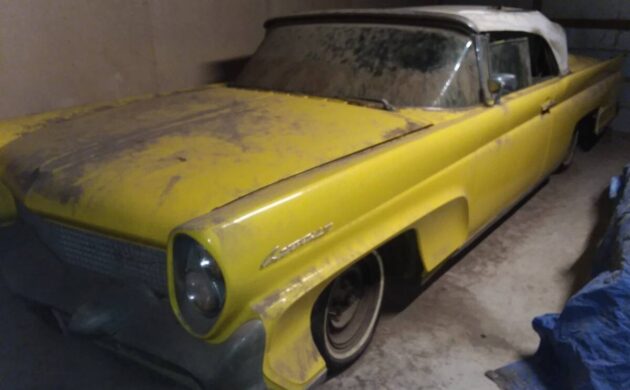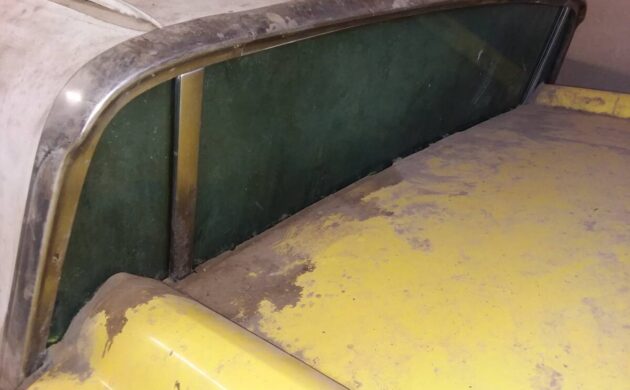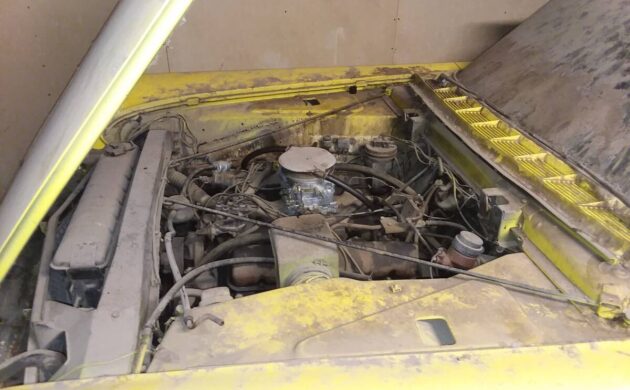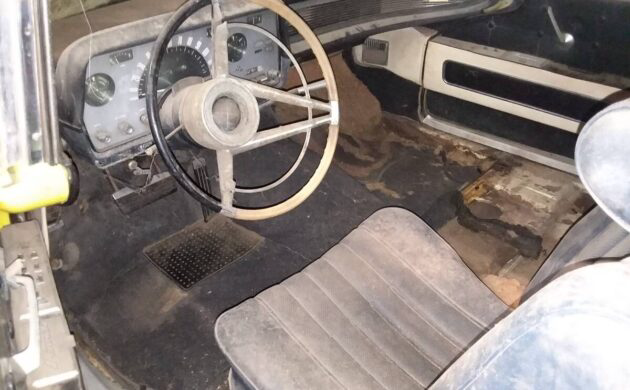In 1938, Edsel Ford commissioned a one-off luxury car to drive to his vacation home in Florida. This car. based on a Lincoln Zephyr convertible but with European flair, proved wildly popular with Edsel’s wealthy friends. A derivative of the ‘vacation car’ was put into production in 1940, and the first generation Lincoln Continental was born. It became the standard-bearer for the luxury car segment. The model was produced in fits and starts – interrupted by the death of Edsel Ford, repeated reorganizations of Ford’s luxury department, the resignation of critical personnel, fiscal issues, and strategic miscalculation – for ten generations. The Continental III belonged to the third generation and was produced in 1958. It was the longest car Ford ever produced, at 229 inches bumper to bumper. Here on craigslist, is a 1958 Lincoln Continental III Convertible project car for sale, for $7,500 firm. The car is located in Escalon, California. Thanks for the tip T.J.!
The seller indicates that this car was purchased in 1965 by the second owner, who then parked it after a divorce in the 1970s. Was marital bliss interrupted by a decision to paint this beast taxi yellow? We’ll never know, but this was not the original color. The most distinguishing characteristic of the third-generation Continentals was the reverse slant roof with breezeway window, included on all body styles. Dual headlights earned this car the moniker “slant-eyed monster” among Ford’s designers.
To move this yacht down the road, Lincoln gave it the 430 cu. in. V8 – shared across the Lincoln/Mercury/Thunderbird platform – paired with a three-speed Turbo-Drive automatic. This combination produced a prodigious 375 horsepower, but you needed every pony. The car weighed just shy of 5000 lbs.
The original configuration of the interior would have been a split-back bench seat in the front and acres of rear seating, all in leather. These cars came equipped with power seats, power windows, and power top, and the convertible got power door locks. However, this was before car makers were thoroughly familiar with electrifying everything. In 1958, all those electrical items made this a massively complicated ownership experience. The top alone has multiple sets of valves, hydraulics, and endless wiring. Meanwhile, this example likely needs an enormous bankroll or a very talented restorer. While the drivetrain is straightforward, just about nothing else is. Furthermore, the controversial styling of this particular series of the Continental has not enjoyed much favor in the marketplace. But let’s say you have a yen for a 1958 Continental: what’s the first thing you would do here?








Nice write-up Michelle. The yellow re-paint is very curious, as much for the color choice but also the thoroughness. Did they pull the engine to do it?
Earl Scheib would have lost his a$$ on this re-paint!
I believe, this was the largest car ever made, for Ford anyway. I read, yellow was a factory color,( Deauville Yellow) although, I’ve never seen one, not that I lived in an area that had Lincoln convertibles running around. I called the rear window the “Breezeway” once on a Merc thread, and someone jumped all over me, it was a “reverse slanted, power operated, retractable rear backlite”, they exclaimed,,sigh, yeah, okay, Breezeway it is.
What does the future hold for cars like this? The convertible, which was, I think kind of the cousin to the Ford retractables, were complicated, they worked well,,,when new. Somethng like this has literally miles of wires, and age and auto electrics don’t go well. Okay, say you DO have the money to restore it, then what? You going to drive this thing around? The only thing this car is good for today, is to show future generations how crazy it was to have a car this big.
We owned – “owned” being the operative word – a 1961 Lincoln Continental for a time. There is a guy (bless his heart) who travels the country in a van fixing the convertible tops for Lincolns only. He likes to fish. So if you have good rivers, he’ll put you on his calendar and after a few months, you will see him in your barn, making a house call for your top. He’s a genius at this. It’s all he has done for years. Except fish.
Re the electrics. He warned us that we MUST keep the windows up when it rains, like allow not a drop into the car, because if a drop fell on the door armrest where the buttons were – for all the locks, windows, etc – that drop would short out the whole car. This is made more difficult by the fact that if you own a convertible, when you unlock the car, the windows automatically drop an inch or so, so that when you open the door, they clear the rain flap of the convertible top. The first time that happened, it totally freaked me out. I told my husband, this thing is Christine, we have to get this fixed. But no. It’s by design. Too clever by half.
So don’t park in the rain.
Michelle [and owners of 1960s Lincolns],
Yes, the switches only need a couple of drops of moisture to cause the switch contacts to quickly corrode and stop working. Because this problem also happens to the sedans if a window is leaking or left partially down, this applies to all the 1961-1970[?] Lincolns.
The problem with the window switches is fairly easy to fix. The actual switch assembly is a 5 sided [open top] plastic box roughly 1 inch square. The switch internal parts are assembled from the top, with the rocker lever sticking up. The factory then sealed the entire assembly with a flexible rubber seal that fit around the rocker switch lever.
Problems developed soon after the cars were out of warranty when the rubber seal failed and no longer sealed at the center, allowing rain water entry. Since FoMoCo didn’t seem to understand what would happen when water filled the switch box, they failed to provide an exit hole in the bottom of the switch. I’ve seen them overflowing with water, sometimes to the point there is no longer any electrical contact points inside, as they corroded completely.
These switches can be disassembled by pushing out the center pivot pin. Drill a small hole in the bottom of the box, in a corner. Then carefully clean the box out and lightly sand the contact points before reassembly. It’s also a good idea to use a product called NO-OX-ID, or a similar conductive lube for electronic switches. Once the box is reassembled, cut small patches of black rubber bicycle inner tube sections to fit over the switch box. After providing a hole in the rubber cover for the switch lever to protrude out, slide the entire inner tube section over the switch box, and glue in place.
A light application of Armor-All once a year to the rubber seals [use a Q-tip] will keep the rubber seals from failing for years to come.
And as a reminder for anyone with a Lincoln or T-Bird with a convertible disappearing top, if the trunk lid won’t unlatch, don’t panic. All you need to do is keep a cheap 3/8 socket wrench, 6″ extension, 9/16 socket, and a flat blade screwdriver in your glove box [NOT IN THE TRUNK!].
In front of each rear wheel in the inner fender, can be found a hex head bolt. Using the aforementioned tools, locate the bolt heads. If they’ve never been removed you will probably need the screwdriver to clean away the undercoating around the bolt head. Loosen the bolts about 8 turns, then push up on the bolts. This will lift the front corners of the trunk lid up so you can insert a wooden shim at each corner. Then simply remove the 2 bolts. With a friend to help on the other side of the car, you can slowly raise the trunk lid [it’s slow going as you are working against the hydraulic cylinders, but it will slowly open up].
I mention this on a regular basis because more than once I had a customer bring his Lincoln in because the trunk lid wouldn’t unlock, and one shop had actually cut the trunk lid sheet metal away trying to solve the problem, and/or caused body damage from trying to pry the trunk lid open!
PS Yes, there were a couple of yellows in 1958 that were factory colors. They were creamy and subdued, classy. However, in 1949, they used a color called Calabash Yellow, which is very close to this one.
I believe Kindig did one of these with a custom V12 engine that probably cost as much as an average home but it was stunning
first I remember these cars when they where new on the show room floor I was 12 in 1958 second on the mercury turnpike cruiser the rear window in the adds in 1957 and 1958 where called breezeway and unless you are over 77 years old I was there in the showroom in 1958
Sadly, you’ll be upside down on day one of trying to resurrect this beast.
Correct. I know someone who did a ground-up restoration on one of these in `94-`96. He spent $127K roughly total, and the car–MAX is worth about $65K. That’s in #A-1 Condition like his was. Something to think about.
Body does not look to bad from pics. Would still need a bunch of work, and $. To bad there are very few drive in movie theaters left, could smuggle like 6 people inside the trunk.
Good job Michelle. I’m with Howard, this is a tough call on a car like this. Today they are viewed as unique and different, but perhaps not from a positive perspective. So someone doing a restoration would be doing it as a labor of love, since the finished value of the car wouldn’t be a big number? (But I guess that is true of most restorations…). No way to do a halfways restoration? In any case, that bright yellow does nothing for this car.
Ford/Lincoln needs to buy this one back, and restore this.
As a kid seeing these Continentals, sure, they looked big to me, but a lot of cars were big in those days. Nowadays when you see one in the context of more modern cars, you can really appreciate just how big they are. Humongous! Can’t imagine simonizing one of these by hand.
I’d have to respectfully disagree with you Todd. My ’63 Riviera is about 17 feet long, so not really any longer than, say, an Escalade or Suburban. The difference is that the Suburban is a LOT taller. SO, when I park my Riv next to some of these modern cars, the Riv looks diminutive by comparison. And definitely more elegant.
Weight? Well, the Riv checks in at about 3950 pounds, which is less than a Mustang GT.
I wonder if the perception that 1960s and 1970s cars were that much larger than today’s car is just a misconception.
I was thinking of late ’50’s cars like Cadillacs and Imperials and also the ’60 Buick Electra 225.
New Mack trucks dwarf this Lincoln, too. I think he’s comparing cars, not trucks.
wow a 1963 riv great car is it a 401 I believe this was the first year for the Buick riv and best looking one I had a 1968 with a 430 loved that car
My dodge caravan measured in at about 17 feet long, just to put size into perspective for the young-uns…
For comparison, a F-150 SuperCrew 5.5′ bed is 232 inches long.
I believe the convertible man with the van and all the knowledge to repair the tops retired. If it’s the same guy that Jay Leno used to repair his Lincoln. You can watch a video of him with Jay talking about his Lincoln vert. It’s a a 66.
The ’58, ’59, & ’60 Lincolns were butt-ugly (imho) and then Ford went on a 189-degree turn-around, designing the ’61.
This car was a disaster from the construction point. It was Ford’s foray into Unibody territory and it did not end up well. These cars were WAY to long for a unibody setup and they flexed too much. Typical on the speedometer gauge ,there would be a vertical crack on the speedo at the 50MPH marker caused by body stress. . Expensive car to restore and sadly, a shrinking market. Much like a lot of these cars we see here. The people who own these cars don’t realize time has passed them by and much like ‘brown’ furniture of today, theyn next generation isn’t interested in them at all.
Well it’s gone already, but why restore a car when you can just pull the top off, and keep all the windows down all the time? It’s a summer car. Add fishing poles and you’re good.
That yellow paint color was popular in the late 60’s early 70’s so that’s probably when this was painted. Not many people these days have a garage that will enclose more that 17ft of car. There are exceptions of course, Along time ago (97) I was driving a concrete mixer in Naples Florida, when the owner a woman was standing outside and came over to talk to me. This surprised me because the lot alone cost ten million dollars and they had to tear down the existing house to build the new one. Anyway she came over and told me the entire under ground area was a garage for her cars which she had a lot of. So apparently some people do have room for any size car or truck. The area she was building her new house in is very exclusive. You can’t even buy in there without first being pre-approved, they turned down
redd Fox.
God Bless America
I live not far from Escalon, California. This is home to the Franzia family. They are very close to the Gallo family of Modesto, California. I hope they will consider donating the car to thenew classic car musium in Modesto. I believe thetax credit might be of greater value than the cash price. There are so very few of these cars left that what does exist should be appraised quite high. Gladly assist someone if very serious about the car and want fresh pictures.
Just saw this same model car given a resto-mod on Bitchin Rides last night. I think it was Kindig’s best work. He put in a 12 cylinder supercharged motor in it. Said it was 23 ft long! Absolutely stunning.
With the price of gas, you are going to see a lot of these big cars being pulled out to sell because the owners are going to give up on that dream of ever fixing them up because they cannot afford the gas to show them up.
I was very good at repairing the electrics on these cars since the dealer could not do it. However, I retired last year.
A truly fugly car surpassed only by the ‘58 Buick. And that’s what we teenagers thought in ‘58.
when I was a teen I had a 1958 loved it was a black on black Impala 348 factory 3 speed lots of chrome and fast
These are some ugly ass cars. A guy I knew had a convertible, blue, blue interior. He had better than 60k in that hunk of s@#t and then rarely drove it because he couldn’t trust it as it always broke down. The 60’s Lincoln’s are beautiful cars but if you have a convertible you had better pray nothing goes wrong with the top. There is a gorgeous 65 in our town, pale yellow with black interior and top. He has spent thousands on the top trying to get someone that can get it to work. Drives it in nice weather but would like to be able to go on some road trips. I told him to ditch it and buy a Imperial convertible, a much better car imo.
Terry,
I agree 100% about selling the Lincoln and buying an Imperial convertible. Problem is, finding one for sale, as production figures were mostly under 500 per year.
I’ve owned 1961, 65, 66 & 67 Lincoln convertibles, and 1963, 64 and 65 Imperial convertibles. The imperials are far better mechanically, and equal in looks starting in 1964, as they were styled by the same people. The Lincolns always needed some minor repairs, adjustments, servicing, but with the Imperials, just change the oil and lube the chassis, and they were far more reliable. I’ve even flat towed a Lincoln convertible behind an Imperial convertible, I wouldn’t even think about the other way ’round! [And yeah, it was a blast, with the tops down on both cars, cruising at 60mph on I-70!]
If I remember correctly those were 228″
Hi Michelle,
You stated in one of your answers that the ’61 Lincoln Continental convertible, the windows went down when you unlock the car.
Having owned a ’62 Lincoln Continental convertible, that’s not exactly true. Nothing moved on the car when unlocked. When you push the button on the rear door handle, THAT window would lower automatically 2 ” to avoid hitting the convertible top when you open the door. Once you got in the rear seat and closed the door, the window would automatically go back up. This was on the rear doors only and only on the convertible.
Iam looking forward to increasingmy collection of luxury Lincolns andPackards. My problem is a good mechanic. I took my 1981 Mark VI to theFord Dealer because the ignition switch broke. Had to replace it, now the cruise control does not work. I believe the center plate on thesteering wheel is also upside down. $125.00 an hour labor rate for this.
Thomas, The first suggestion I have for you is to join PAC [the Packard Club], and LCOC [Lincoln & Continental Owner’s Club], if you’ve not done so already. Like most marque clubs, they have membership lists and a list of people who specialize in specific years or series. Living in So Cal I’m sure you can network with club members in your general area to find someone who has the experience, knowledge, and a willingness to work on your cars.
As for new car dealerships, NEVER take a car more than 10 years old to a factory dealership. New car dealership service departments loathe working on older vehicles. Many of the mechanics working at dealerships are under the age of 30, and have no clear knowledge of repairing older vehicles, and probably don’t have access to the repair manuals. Except for tires, some factory dealerships are forbidden to stock spare parts except for what the factory parts division offers. Some manufacturers don’t even allow their own dealer parts departments to order spare parts from aftermarket places Like NAPA. [Manufacturers dealer contracts allow them to audit the dealer’s finances at anytime or for any reason, to keep them in line.]
In the 1970s I was service manager or assistant service manager at several new car dealerships, both foreign and domestic. I know the only way mechanics can make a decent living is to do repairs fast enough to beat the times listed in the labor guides. This means they have to cut corners and get the car ‘out the door’ ASAP. If the labor book says the job takes 3.5 hours, the mechanic is expected to get the car out the door in under 2 hours.
I’ve actually been forced to send mechanics home early when they refused to work on older vehicles because they knew it paid less, and also lowered their weekly compilation of labor hours earned for the dealership. I’ve seen paperwork from a major dealership chain requiring mechanics to maintain at least 80 labor hours per 5 day week.
Ideally you want either a shop that works only on older vehicles. or a repair shop owned/operated by a person who is really into older vehicles, probably has a couple himself, and older mechanics on his team who understand your vehicle.
This cloth seat being shown in the pictures of this 1958 Lincoln Continential is from a Mercedes Benz 280 sedan I am sure. I know where this building is. I travel around Escalon often. There is a good 12 classic cars some going back to 1919 and a 1956 Lincoln Conv. is or was in there also.
I remember mychildhood and can place where I was living by the new cars back then. When the 1951 Mercury came out I was movingfrom Witchita, Kansas to Atlanta, Ga. When the 1953 Cadillac I was moving to Detroit where I stayed for 22 years and a grad of Univ. of Detroit in accounting. Worked at Kelsey hayes for several years and learned a lot about autos and the industry. Went to Texas in 1975 and bought a new 1975 Imperial that year. Now retired in central California, still deal in vineyards and wine.
I did also see one done on Kindig’s show and was blown away by the unibody. It was way ahead if its time but I didn’t know they flexed so much as stated above. I’m used to the x body frames for convertibles so it makes sense that it failed. As far as Ugly, that is subjective. Chrysler had the fugliest ones in the early 60’s. My Mom’s 57 Beldevere was junk with a broken torsion and a rear spring that had my Dad in fits. I commend anyone who takes this on. It is a cool car. I think I’d lose the hydraulics and simplify it if possible but easier said then done. Like A Rolls Royce, when someone says hydraulics- old air ride, I cringe.
I sure enjoyed reading what Bill McCloskey had to say about dealership service departments. I am also appreciative. This sure gives support to the value of having a site like this one where we can express ourselfs. Bill, thank you greatly !!!
Thomas, thanks for the kind words.
Just purchased a 1971 New Yorker that had been a garage for 35 yrars. Have in the hands of an independant repair shop, AAA approved. Have all the papers from when car was new. Have the window sticker. Var ownership went from mother to son and now to me with last regesteration being 1986. Car does not have a single flaw or ding, Astic gold and with several options.Will have ir in car shows in August.
Congratulations! I love finding cars with fat files. This one sounds great!
My 1975 Imperial had a total length os 232 inches. We maintain a 2005 Cadillac stretch that is used for visiting wineries. I tell people tjat the limo is so long that the phone up front has a different area code from the phone on the back
It’s getting flipped. New price is $12k
I was about to write here that I am within 40 miles of an automobile museum that closed up and has several luxury cars like this one. Heck this is the place and I remember this car and also a 1956 Lincoln Conv. This museum is located very close to Franzia Wines. Plan to pick up a few cases of wine along a purchase from this museum. I wish to offer a toast to the creator of this web site and the opportunity for us to make these comments and we build on each other. This is so enjoyable.